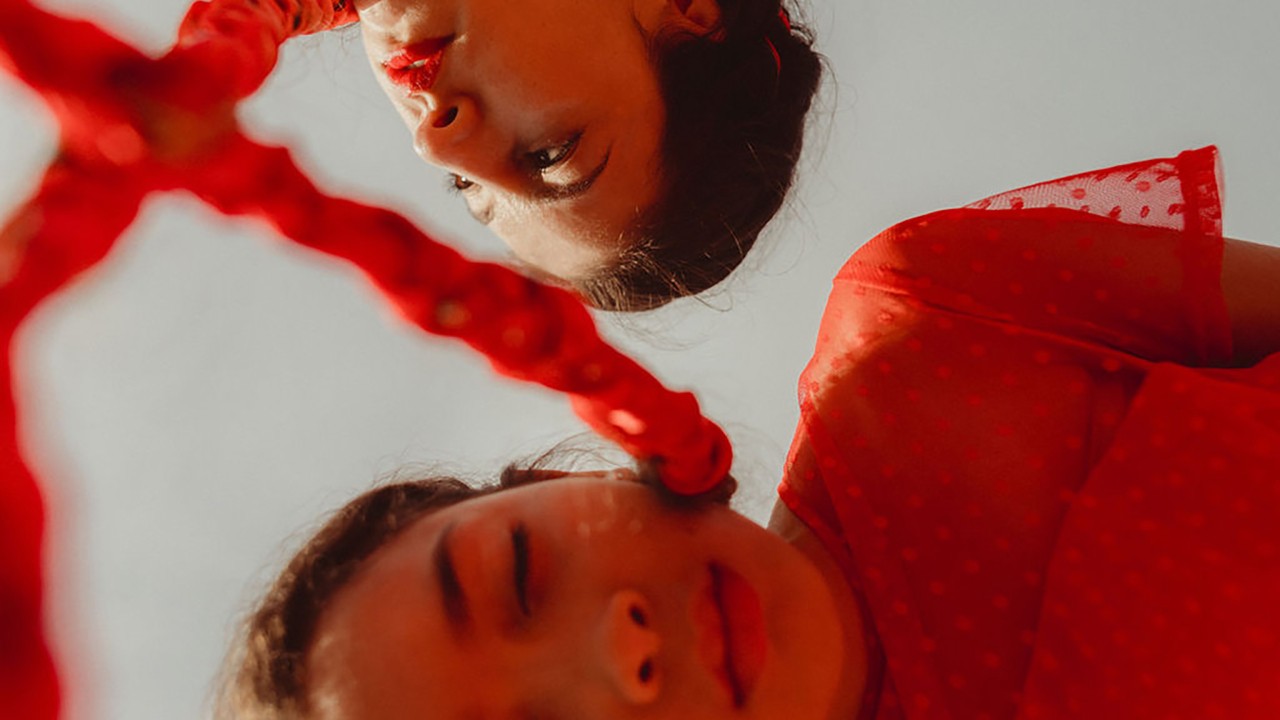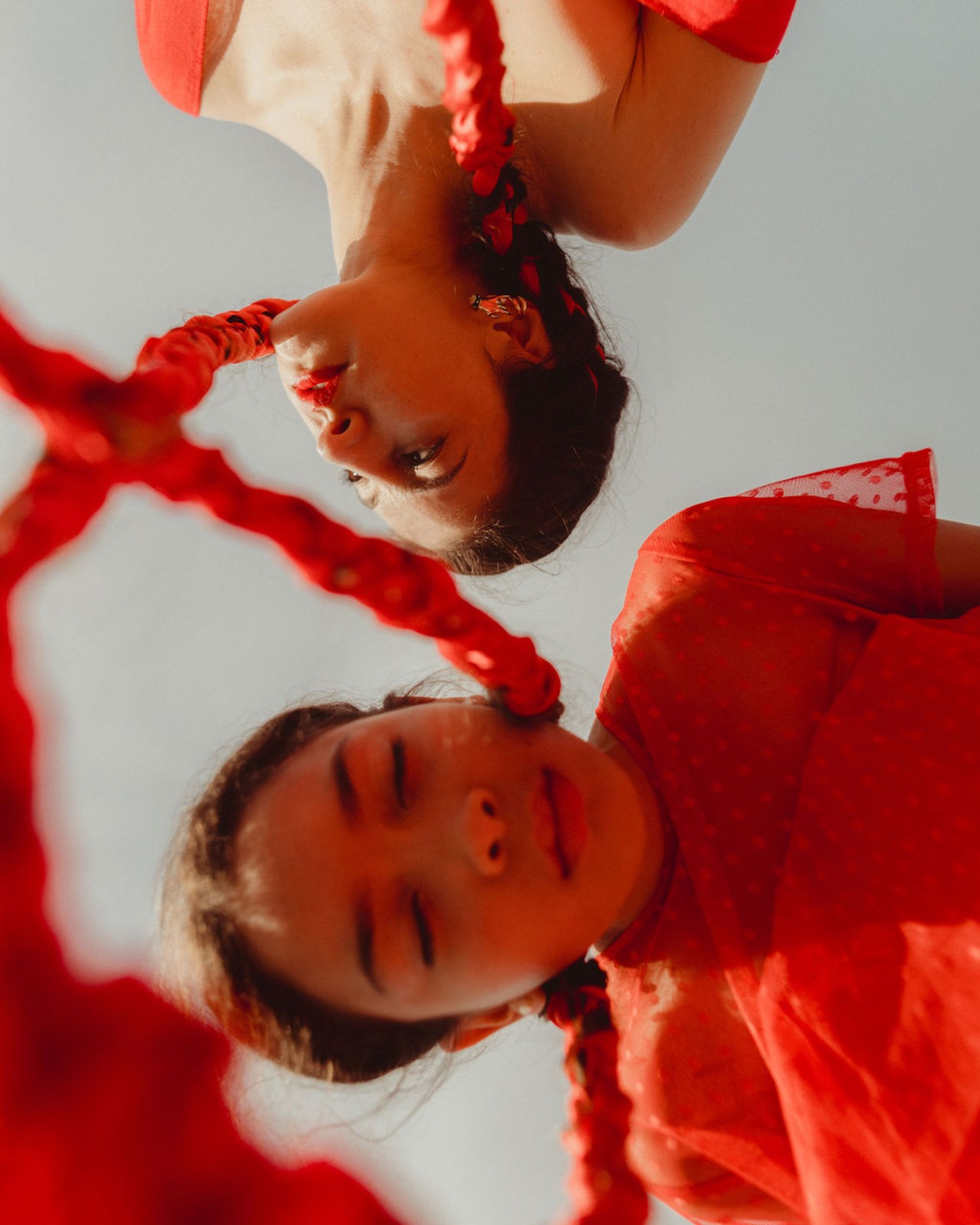

Photograph by Celia D. Luna
WORDS BY YESSENIA FUNES
Danié Gómez-Ortigoza isn’t the sort of person you miss. In a room of people, she stands out in the most iconic way. The 38-year-old Mexican artist often wears her hair in a crown braid with fabric woven in between. This look is but one element of her art, which revolves around the ritual of braiding. She adorns herself in such twists to tell a story—a story of unity and kinship. A story the world sorely needs right now.
“Imagine if we could come to a point where every time we see a braid, we have this second of remembering that it’s all about coming together,” Gómez-Ortigoza tells me.
I meet her in Miami, where she spends half her time. It’s March, and she’s preparing to hit the main stage at Aspen Ideas: Climate, a three-day conference where government officials, activists, and industry people from around the globe gather to share ideas on how to respond to the climate crisis. I spot her white headpiece. She is dressed in white and gold but flaunts a bright red lip. There’s gold jewelry on her ears, chest, wrists, and fingers. Her ear lobes are held by earrings delicately shaped like hands.
Hands are essential to Gómez-Ortigoza’s work. She braids with them. When she hits the main stage, she instructs the room full of suit-clad attendees to breathe in and breathe out. She directs us to connect with a stranger. She reminds us, “You are here to design the future.” Then, she pulls out a red silk from her pocket and begins braiding. I see a blue string attached to the seat before me. I join her. We all do. We braid together.
I didn’t immediately understand how her work related to climate change. After talking to her and seeing her live, the connection became clear. A braid is crafted from three separate strands. It’s only when those pieces wrap around one another that they become a braid. It’s only together that they become elegant and organized.
Imagine what would be possible if everyone came together to tackle the climate crisis. How beautiful and effective would we be? Braiding forces us to slow down. It’s intimate, whether you’re gazing at yourself in the mirror as you braid your own hair or running your fingers through someone else’s. Imagine the walls that could come down—both inside ourselves and with others—if we took the time to nurture and connect.
Gómez-Ortigoza holds braiding circles about once a month where women and girls braid each other’s hair, often connecting their tresses through interwoven textiles. In these spaces, people sometimes dance. People sometimes cry.
“It’s deeply powerful,” Gómez-Ortigoza says. “Our hair, it’s our whiskers to the world.”
“What I have been trying to do through braiding is materialize the invisible thread that brings us together.”
I can’t remember the first time I braided someone’s hair. Was it my own? Was it my sister’s? There is one memory I do have: I am still in grade school, and my childhood best friend is throwing a birthday party. It’s my first time in her house. I think it’s my first time in any school friend’s house. She offers to braid my hair into cornrows. She is Black. I am not, yet she opens a portal into her culture as she pulls and pats my hair. We giggle as girls do, finding safety in each other’s company.
An invisible barrier silently disappears. An invisible thread unites us, instead. This ethos is foundational to Gómez-Ortigoza’s work.
“The big things, which are the ones that unite us on the deepest level, are things we cannot see,” she tells me of ideas like love, fear, and God. “What I have been trying to do through braiding is materialize the invisible thread that brings us together. The moment when we’re able to see the things that unite us instead of the ones that divide us, that’s when we start seeing the humanity in the other.”
During the last Ice Age some 30,000 years ago, the world looked a lot like a snow globe. Some of the earliest humans lived alongside wooly mammoths and saber-toothed cats. Around this time, our ancestors began to create art. Prehistoric sculptures like “Venus of Willendorf” also suggest that our ancestors knew how to braid even then. In “Venus of Brassempouy,” one of the oldest portrayals of a human face, the tiny figurine shows a woman’s head—and lines and lines of braids.
These ancient artworks inform much of Gómez-Ortigoza’s practice. “Braids have been part of our society forever,” she told me. “It’s this social act that has connected generation after generation, especially in Indigenous communities or African Americans.”
Society must look to creative artists like Gómez-Ortigoza as we contend with the climate crisis, said Shannon Martin, an enrolled citizen with the Match-E-Be-Nash-She-Wish Band of Pottawatomi Indians in Michigan and a participatory strategic planner with the University of Massachusetts at Amherst’s Center for Braiding Indigenous Knowledges and Science, which works on climate change.
“I want to commend the artists because they have deeper connections to the messages of creation and a connection to our ancestors that transcends most people,” said Martin, who is also a member of the Lynx Clan and a locally recognized knowledge keeper. “They bring forward those teachings in ways that are very powerful.”
She sees this emanating from Gómez-Ortigoza’s braiding practice—a practice her Indigenous peoples have known for millennia.
“Mother Earth taught us about the importance of hair as medicine,” Martin said. “From our ancestral times, our hair is significant because it carries and holds our experiences. It represents our strength.”
In her Indigenous culture, a braid’s three strands represent the past, present, and future. This worldview underscores the connections between these spaces. We can honor our ancestors by being good ancestors ourselves and taking care of the Earth for those who have yet to arrive.
“You want to leave this everlasting impact,” Martin said.
She also believes braids can teach us the value of bringing cultures and knowledge together so that we can all learn from one another. Indeed, the center where Martin works is dedicated to doing this between the scientific community and Indigenous communities so that they can jointly solve challenges around food sovereignty and climate calamity.
“From our ancestral times, our hair is significant because it carries and holds our experiences. It represents our strength.”
Gómez-Ortigoza folds these teachings into her own rituals, passing along similar understandings to her audiences. She was taught the power of braids by an elder: Doña Blanca, a nanny who used to braid her hair on special occasions, especially when she had a performance at school. Even as a child, Gómez-Ortigoza enjoyed being on stage. Her nanny was the daughter of a powerful shaman; she would turn to herbal remedies when Gómez-Ortigoza or her sister would fall sick. She’d also share stories of her past while twisting her fingers through her hair. Gómez-Ortigoza lost touch with her nanny, but she didn’t stop wearing her hair in braids.
“Braids truly became a shield for me,” Gómez-Ortigoza said. “An armor into the world.”
These days, her work is multi-dimensional. There is the braiding itself, but also spoken word and performance. Climate is one theme her art touches; there’s also sisterhood and identity.
Soledad Lowe, a friend and artist who also integrates themes around climate change into her work, met Gómez-Ortigoza nine years ago. She said it’s been beautiful to see Gómez-Ortigoza develop her own artistic language while always staying authentic. “She’s always been close to nature,” Lowe said of Gómez-Ortigoza. Her message about the invisible thread that binds us all also includes our connection to nature.
Lowe admires how Gómez-Ortigoza raises environmental awareness through braiding. “Everything helps. We can sit there and hug a tree, and we can strike. This is another way—a very peaceful way—to raise awareness, as well,” she said.
Ximena Caminos, a peer and founder of Miami Beach’s underwater sculpture park The ReefLine, sees great value in Gómez-Ortigoza’s work, especially as people seek inspiration to tackle the growing climate crisis.
“I believe that art has the power to heal and to connect people and to transform,” she said. “At the same time, art is such a powerful tool to tap into public sentiment when data and science and numbers [make] people numb.”
The braid teaches us all a valuable lesson we’ll need to confront the gravity of our changing planet: balance. “It’s impossible right now to stop climate change,” Caminos reminded me. But how do we live with what’s already baked in? How do we adapt? How do we stop the problem from worsening? We know the worst is yet to come.
Well, we breathe in and breathe out. We connect with strangers. We braid our cultures, pulling one strand, then the other, to the center. We find a balance. We find a flow. We build common ground. Together.
This is the message in Gómez-Ortigoza’s work. “How are we going to choose what the present and what the future will look like?” she said. “What are the strands that we will actually hold and braid into this social fabric?”
Sometimes, after she stares herself down in the mirror to braid her hair, she tucks a piece of paper underneath her crown. There, she writes an intention. “What are the elements of power that I need today?” she asks herself. Some days, it’s courage or freedom. Other days, ancestral wisdom.
As we collectively enter a period unlike any our species has faced before, we’ll need our own elements of power. Even in the very beginning, humans created art and braided hair. Maybe, we trust in our ancestors and start there. Maybe, we look to the past to guide us. Maybe we heed Gómez-Ortigoza’s call.
Correction,
April 10, 2024 11:06 am
ET
This article was updated to correct Shannon Martin's affiliation as an enrolled citizen with the Match-E-Be-Nash-She-Wish Band of Pottawatomi Indians.
Danié Gómez-Ortigoza: Hair Braiding To Unite the Climate Movement